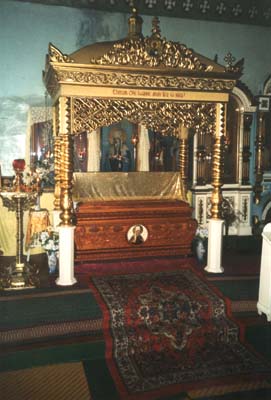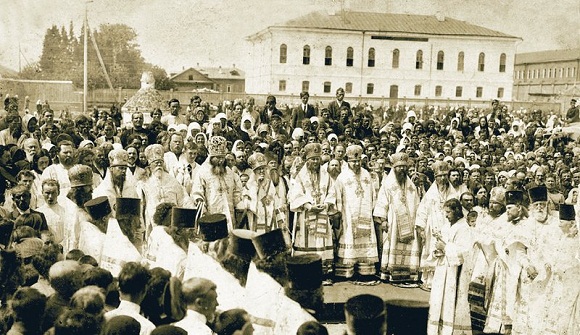St. John (Maximovitch), Metropolitan of Tobolsk, whose memory we celebrate today, is today best known by many only as the ancestor and patron saint of St. John (Maximovitch) the Wonderworker, Archbishop of Shanghai and San Francisco. Yet the life of the first St. John (Maximovitch) is at least as remarkable as that of the second, as demonstrated by the following sermon, originally given in the Cathedral of St. Nicholas and Ioasaph in Belgorod.
Our Holy Church celebrates the memory of St. John, Metropolitan of Tobolsk, on June 23. He was the last Russian saint to be glorified by the Church in pre-revolutionary, tsarist times. To a certain extent, the canonization of the God-pleaser John could only have taken place thanks to the personal insistence of the Tsar-Martyr Nicholas II and his most august spouse, the Tsarina-Martyr Alexandra Feodorovna, who shared a profound veneration for the Siberian wonderworker. In the resolution of Nicholas II regarding the canonization of the saint, we read: “I believe in the intercession of St. John (Maximovitch) in this time of travails for Orthodox Rus’.”
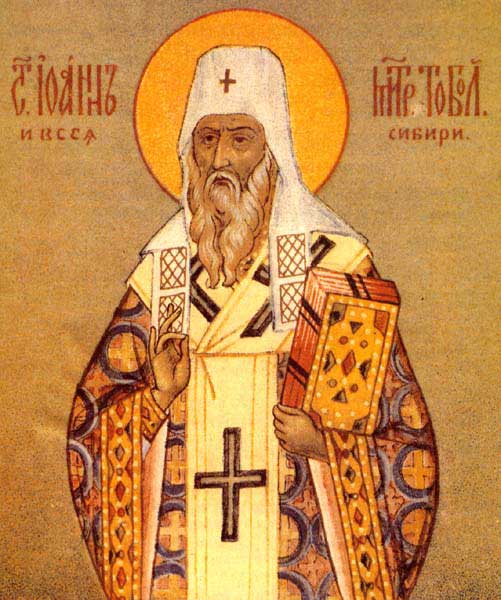
Like St. Ioasaph of Belgorod, he was a native of the Ukraine and a descendent of an ancient noble family. He was born in the middle of the seventeenth century, in 1651, as the oldest son in a family with seven more sons. His pious parents strove to provide him with the best education then available. After giving him a wholly church-centered upbringing at home, they gave their first-born son to the Kiev Theological Academy, where he grew close to the ascetic strugglers in the Kiev-Caves Lavra; he himself became a monk around the age of twenty-four. With the general consent of the monastery brethren, the young monk was given the important obedience of preaching. There is evidence that the future saint’s preaching activity in the Lavra lasted for five years. Only three of the sermons he gave in those years have come down to us. Composed in accessible, conversational language, and free from rhetorical devices, these works of the young ascetic were full of life.
From that time forward his primary goal in life was defined by this question: “How to align my human will with the Divine will?” The answer to this question came in his literary work, Heliotropion (that is, “The Sunflower”). Just as this remarkable plant always turns towards the sun and light, so too should we always turn to God and the Gospel in order to align our will with, and build our lives on, the Law of God.
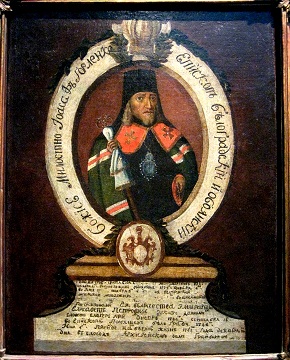 Meanwhile, the Ukraine was under real threat of Turkish occupation. At this difficult time, the Ukrainians decided to ask help from Russia. An embassy was sent from Kiev to the Russian Tsar in Moscow that included the twenty-four-year-old monk John. In 1685 the Russian Patriarch Joachim appointed him deputy abbot [namestnik] of the Svensky Monastery near Bryansk. How closely this resembles the life path of our St. Ioasaph! It is also interesting that nearly all the holy hierarchs of this era – Innocent of Irkutsk, Dmitri of Rostov, Theodosius of Chernigov, John of Tobolsk, and Ioasaph of Belgorod – were of Ukrainian origin. Incidentally, ten years later St. Theodosius of Chernigov would choose Hieromonk John (Maximovitch) as his episcopal successor; before his blessed repose he put John forward as the only candidate, although a Little Russian Rada [Assembly] was called to elect the new bishop. At that time in the Ukraine, not only hetmans were elected, but even church hierarchs. In its gramota, the Rada characterized the now-Archimandrite John as “a man of piety, a monastic from his youth, and known as a skillful preacher of the Word of God.” Thus John (Maximovitch) was unanimously elected as Bishop of Chernigov by both the civil authorities and the Orthodox clergy. The Russian Patriarch Adrian confirmed his appointment to the see of Chernigov and Tsar Peter I. The Patriarch, moreover, blessed him “to serve in the sakkos.” In those days few bishops were granted this honor; before the abolition of the patriarchate only Patriarchs and Metropolitans served in the sakkos.
Meanwhile, the Ukraine was under real threat of Turkish occupation. At this difficult time, the Ukrainians decided to ask help from Russia. An embassy was sent from Kiev to the Russian Tsar in Moscow that included the twenty-four-year-old monk John. In 1685 the Russian Patriarch Joachim appointed him deputy abbot [namestnik] of the Svensky Monastery near Bryansk. How closely this resembles the life path of our St. Ioasaph! It is also interesting that nearly all the holy hierarchs of this era – Innocent of Irkutsk, Dmitri of Rostov, Theodosius of Chernigov, John of Tobolsk, and Ioasaph of Belgorod – were of Ukrainian origin. Incidentally, ten years later St. Theodosius of Chernigov would choose Hieromonk John (Maximovitch) as his episcopal successor; before his blessed repose he put John forward as the only candidate, although a Little Russian Rada [Assembly] was called to elect the new bishop. At that time in the Ukraine, not only hetmans were elected, but even church hierarchs. In its gramota, the Rada characterized the now-Archimandrite John as “a man of piety, a monastic from his youth, and known as a skillful preacher of the Word of God.” Thus John (Maximovitch) was unanimously elected as Bishop of Chernigov by both the civil authorities and the Orthodox clergy. The Russian Patriarch Adrian confirmed his appointment to the see of Chernigov and Tsar Peter I. The Patriarch, moreover, blessed him “to serve in the sakkos.” In those days few bishops were granted this honor; before the abolition of the patriarchate only Patriarchs and Metropolitans served in the sakkos.
One of the new bishop’s first acts was to raise Abbot Dmitri of Yeletsky Monastery – the future holy hierarch of Rostov – to the rank of Archimandrite. Thus, inheriting the cathedra held before him by a saint, he passed along his first gift of grace to another saint.
It should be said that St. John held the memory of his predecessor, Vladyka Theodosius, in great reverence. Once, during a time of severe illness, St. Theodosius of Chernigov appeared to him in a dream and said: “Serve tomorrow and you will be in good health.”
The next day, while serving the Divine Liturgy, Bishop John did in fact feel better. This miraculous healing served as the beginning of St. Theodosius of Chernigov’s renown as a grace-filled saint of God. The wondrous spiritual connection between these two holy hierarchs was revealed by the Lord through their very canonizations. Both were glorified two hundred years after their repose. Moreover, the solemn opening of the relics of St. Theodosius of Chernigov was the first to take place during the reign of the Tsar-Martyr Nicholas II, and that of St. John of Tobolsk was the last during this holy Sovereign’s reign.
Another case of heavenly assistance by St. Theodosius of Chernigov to St. John is also known. The saint’s intercession saved Bishop John from the slander of the traitor Mazepa, who tried to falsely denounce him before Peter I. [1] The Tsar saw through everything and St. John’s innocence was fully established.
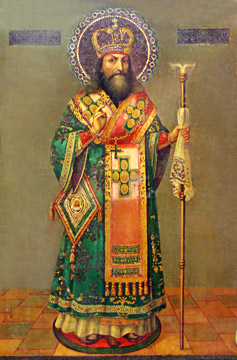 Several extant royal gramotas demonstrate the special favor in which Peter I held Vladyka John, as does the emolument he received from the Tsar. During this period several great holy hierarchs labored in the Russian Orthodox Church: Sts. Mitrophan of Voronezh, Dmitri of Rostov, and Theodosius of Chernigov, all of whom Vladyka John knew personally, serving for him as constant examples of the spiritual and ascetic life.
Several extant royal gramotas demonstrate the special favor in which Peter I held Vladyka John, as does the emolument he received from the Tsar. During this period several great holy hierarchs labored in the Russian Orthodox Church: Sts. Mitrophan of Voronezh, Dmitri of Rostov, and Theodosius of Chernigov, all of whom Vladyka John knew personally, serving for him as constant examples of the spiritual and ascetic life.
Shortly after he began administering the Chernigov Diocese, St. John founded a theological seminary that his contemporaries referred to as the “Athens of Chernigov.” This theological school became widely known in Russia; it was essentially the first Russian seminary and served as the model for seminaries that opened in other dioceses. Vladyka himself served as its Professor of Latin. St. John’s teaching experience is reflected in Peter the Great’s Spiritual Regulation, in which we read: “Foolishly do many say that learning is the begetter of all heresies. Good and sound learning is the source of great benefit, both for the Fatherland and the Church.”
The saint also established a printing press, where many of his best works on spirituality and morality were printed, among which the most notable were The Royal Way of the Cross, O Theotokos and Virgin, Spiritual Thoughts, and The Wayfarer. A century and a half later, The Royal Way of the Cross would become St. Ambrose of Optina’s most beloved book; he always kept sufficient quantities for presenting to his more honored guests.
This good shepherd guided his flock in Chernigov for fourteen years. But in March 1712, to the great sorrow of the people of Chernigov, he was appointed Metropolitan of Tobolsk and All Siberia.
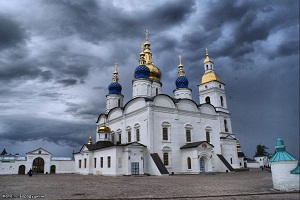
On the one hand, of course, gaining the rank of Metropolitan was an advancement. But on the other hand, the transfer to Tobolsk – bearing in mind the difficulties in Siberia, the remoteness of the area, and the severity of the climate – could have been seen almost as an exile. There were rumors that the Metropolitan’s transfer to Siberia was the work of the all-powerful Menshikov. [2] The fact of the matter is that one of the estates of the Tsar’s favorite was located within the Diocese of Chernigov. Once St. John received an invitation from Menshikov to consecrate a house chapel – with the day for the consecration already noted. Vladyka, however, remarked that it was the responsibility of the bishop, and not of a prince, to appoint a day for the consecration. St. John then appointed a day suitable for himself. Inasmuch as it took place during a fast, Vladyka left immediately after the consecration, refusing refreshments. Following this incident, Menshikov began to harbor resentment against Vladyka, and soon arranged for his removal from the diocese. The saint spoke these prophetic words: “Yes, I have a long way to go. But he will have to go even further than I.” As is well known, soon after the death of Peter I, the all-powerful Menshikov fell in disgrace, exiled to Siberia, and stripped of all ranks and orders. He ended his days in far-away Berezovo. At the same time, the words of Peter I himself were fulfilled: “Menshikov was conceived in iniquities, and in sins did his mother bear him, and in knavery shall his life end.” In Siberia there is a tradition that when the banished Menshikov was sailing under escort along the Irtysh River on a raft, the saint, who by that time had already reposed, appeared at the riverbank, made a full prostration in the direction of the boat, and blessed it.
But all this was to come. For now, Vladyka had to leave his native Ukraine, where he had lived for fifty-eight years. Here he had once left behind his parents, brothers, and ancestral home. Now he had to leave behind his motherland. Lying ahead of him was far-away Siberia, with its intense cold and native peoples who did not know Christ.
But what kind of sacrifice would this have been had he not offered that which was most precious to God, including his freedom and will? After all, throughout his entire life Vladyka sought not personal gain, but the profit of many [1 Corinthians 10:33], which also meant those natives made by the Creator in His image and likeness, but abiding in darkness and the shadow of death. It remained for him to enlighten this darkness with the light of the Gospel, if only he would have the strength: “Lord, may Thy will be done! For the strength of God is made perfect in weakness.”
Vladyka left Chernigov for Moscow with a large retinue of thirty-six people. From Moscow to Siberia only seventeen people accompanied him. And only three arrived at Tobolsk: Vladyka, his cell attendant, and their coachman.
It should be noted that Tobolsk was founded at the same time as our Belgorod, but its first bishop was sent there only in 1620, under Tsar Michael I.
The Siberians joyously greeted Metropolitan John, and were not mistaken in their joy, for the saint was to initiate truly apostolic preaching in Siberia, attracting many thousands to Christ. Metropolitan John’s episcopal service in Siberia was short – only three years – but it could be called the “deliverance from darkness” of many Siberian peoples. It bears mentioning that Tsar Peter’s attitude towards Vladyka John was very benevolent. Despite his enormous responsibilities, the Sovereign strove to reply to each of Vladyka’s letters, each time attaching monetary assistance. Of course, cut off by a large distance from the center of Russia, the saint did not have an opportunity to participate in certain important governmental and ecclesiastical affairs, but he followed them to whatever extent possible. So, for example, when news of the victory of the Russian troops over the Swedes reached Tobolsk, Vladyka wrote a warm letter with prayerful good wishes to Peter I.
During his short time in Tobolsk, more than twenty orphanages and almshouses were constructed. Like St. Nicholas the Wonderworker, Vladyka frequently walked through the city at night secretly to distribute clothes and money to the poor. Naked, and ye clothed Me: I was sick, and ye visited Me [Matthew 25:36]. Vladyka was often seen in places of detention, both in prisons and among those sentenced to hard labor. To gladden the prisoners with unexpected gifts, to comfort them with the words of the Gospel, and to present them with gifts for Nativity or Pascha – all this brought a quiet joy to Vladyka. I was in prison, and ye came unto Me [Matthew 25:36].
Vladyka also ordered repairs to be done, old churches restored, and new churches built in the cities and villages of boundless Siberia. How many natives he Baptized – Zyrians, Ostyaks, Tartars, and Voguls – is known to God alone.
According to the Siberian chronicle, the first missionary journey brought little success, although many idols and graven images throughout the taiga were destroyed. The second journey, in 1713, was much more successful. Many were Baptized and eagerly listened to the missionaries’ preaching. Resistance to the mission was met with at only one location, on the Ob River. Here, clearly by Divine Providence, a ship with missionaries ran aground. The natives cried out: “Get away from us, old man! We will not accept your faith because it rejects our gods!” However, scorning the threat of massacre, the missionaries walked to the shore in water up to their chests, bearing the Cross and the Gospel. Even before reaching the shores, they entered into conversation with the angry mob. For two days they exhorted the natives, who were maddened by demons. On the third day all were Baptized. During this journey alone, 3,500 natives were Baptized – an enormous number for those days. I am the good shepherd: the good shepherd giveth His life for the sheep [John 10:11].
Once, with the help of a Tartar prince to whom Vladyka had shown much kindness, on a single day he managed to Baptize nearly 300 Tartars, who immediately requested permission to build a church. Vladyka personally donated to this church an icon of the Mother of God called the “Galaktotrophousa” with a handwritten inscription.
It is interesting to make note of a pious custom that existed in Tobolsk in those years. On Palm Sunday the bishop would be seated on a horse and led through the city, led by the governor of Siberia. The bishop would bless the people with the sign of the cross and sprinkle them with holy water, while the choir and deacons joyfully cried out: “Hosanna in the highest! Blessed is he that cometh in the name of the Lord!”
Vladyka gained fame in Siberia as a missionary, religious writer, and pioneer of theological schools. The territory under his omophorion, from the Urals to Chukotka, was twice the size of Europe.
Vladyka derived special joy from literary work. The Siberian chronicle testifies to this: “He had one diversion and recreation: to write edifying works.” This handwritten document was kept for many years in the library of the Tobolsk Theological Seminary.
In his everyday life, Vladyka did not tolerate amusements and entertainments. Tireless in his diocesan work, he was a man of fervent prayer, dedicating every free minute to this labor, so difficult yet sweet. Even during his lifetime, the people of Siberia knew him as a man of clairvoyance, strict fasting, and bold prayer.
Vladyka’s ties to the Holy Mountain of Athos, to which he sent large donations during their difficult years, are also known. A gramota witnessing to his help to the Athonites during the difficult time of Muslim domination is preserved at the Russian Monastery of St. Panteleimon. It was with Vladyka’s blessing that Hieromonk Hippolite of Chernigov traveled to Athos, Jerusalem, and Sinai.
Another of Vladyka’s traits should also be mentioned: he never appeared in secular society. Only once did he dine with the governor, and then only because of the latter’s insistence. The modesty of his refreshments, when receiving guests after services, was made up for by his wise words in conversation. The same chronicle says of him: “He was quiet, modest, prayerful, and compassionate towards the poor. He left an indelible mark on the minds of the people, who saw in him a saint of God.”
The saint was undoubtedly forewarned of the day of his blessed repose. The last day of his life became a literal fulfillment of the Lord’s words. On June 9, 1715, after celebrating the Divine Liturgy, the saint unexpectedly ordered the table in his home to be laid. He offered a plentiful meal for all, during which, like the Savior, he girded himself and began to wait upon those eating. He then parted touchingly with the clergy, retaining two especially beloved priests for some time. What he spoke to them about remains unknown. Having dismissed them, he retired to his cell and shut himself in. The next morning Vladyka did not come out. The clergy meanwhile began to assemble in front of his residence, but they knocked and cried out in vain. When people began to assemble, the governor was called for. Once he had arrived, he crossed himself and ordered the doors to be broken. An extraordinary sight presented itself to the onlookers: having already given his soul to the Lord, Vladyka was kneeling before an icon of the Mother of God next to an extinguished candle. The prayer he had begun on earth was continuing in eternity before the Throne of God. This marvelous occurrence is testimony that the saint, following his repose, stands in prayer before God and His Most Pure Mother for all of us who live on earth and turn to him for help. Sincerely mourned by his orphaned flock, he, as befitting a monk tonsured in the Kiev-Caves Lavra, was buried in the side chapel of Sts. Anthony and Theodosius.
How much he has in common with St. Ioasaph! Both came from the Ukraine, from ancient and noble families. Both fulfilled their obedience in the famous Kiev-Caves Lavra and graduated from the Kiev Theological Academy. Both had heavenly patrons in their early youth: for one, it was St. Athanasius of Constantinople; and for the other, it was St. Theodosius of Chernigov. Both were beloved by members of the Romanov dynasty. Both gained fame for their literary works. Both were numbered among the saints during the reign of Nicholas II. Both saints were preserved incorrupt following their repose, for the Lord keepeth all their bones [Psalm 33:20].
Today, celebrating the memory of this wondrous saint, Metropolitan John of Tobolsk, we who live in the third millennium – so far removed from our holy hierarchs in time, but so close to them in faith and spirit – should follow them as our spiritual guides in prayerful boldness towards the Sweetest Lord Jesus Christ, our Holy God, Who is living, near, and dear.
Translator’s notes:
[1] Ivan Stepanovych Mazepa (1639-1709) was a Cossack Hetman who deserted his army before the Battle of Poltava and sided with Charles of Sweden.
[2] Aleksandr Danilovich Menshikov (1673-1729) was a statesman and military commander who was a great favorite of Peter the Great.
Translated from the Russian












